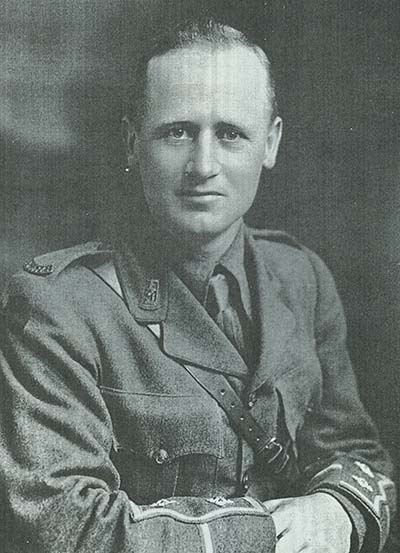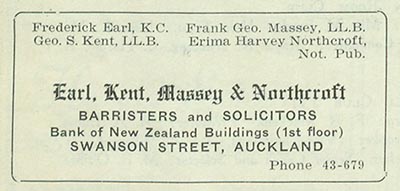
Acting Major Frank George Massey.Private collection.
Frank Massey
Frank George Massey had a distinguished military career during the First World War, reaching the rank of acting Major and earning multiple military awards.1 He was seriously injured while leading the 11th Battalion of the Lancaster Fusiliers in a charge during the German Spring Offensive of March 1918.2
Massey was the third son of Christina and William Ferguson Massey, Prime Minister of New Zealand from 1912–1925. Known as George, Massey was born in Mangere in 1887 and lived for most of his life at the Massey Homestead on Massey Road in Mangere East.3 William Massey purchased this property in 1890 and it was passed on to George in 1928 following his father’s death in 1925.4 Massey was educated at Mangere District School and Auckland Grammar School.5 He attended Auckland University College from 1908–1909, but it was not until 1919, after returning from service, that he received his LL.B.6
Wartime
Massey volunteered for service on 28 April 1915, giving his address as the law firm he worked at on Queen Street, and his father as his next of kin.7 He married Dora Grainger before embarking as a Second Lieutenant with C Company of the 2nd Battalion of the New Zealand Rifle Brigade on 4 October 1915.8 He spent the majority of the war on the Western Front.9 He was awarded the Military Cross and the Distinguished Service Order, and was mentioned in despatches three times.10 His Military Cross was awarded for his ‘invaluable service to his brigade in successfully carrying out its assembly arrangements’ in preparation for an attack at Messines. His ‘careful personal reconnaissances’ meant that there were no hitches in the attack, and in the midst of the action he ‘did valuable work in going forward when communication had broken down owing to casualties and other confusion, and returning with a clear report upon the general situation’.11
In late 1917, Massey was seconded to the Lancaster Fusiliers and was acting Major of the 11th Battalion during the German Spring Offensive in late March 1918.12 After being shot in the chest while leading the Battalion in a charge during this offensive, Massey was found by his batman and friends in the mud among the dead and wounded. Due to the persistence of these men in the face of a 'no-hope' diagnosis, a doctor was found who was willing to operate and the bullet was removed.12 He received the Distinguished Service Order for his part in this action. ‘During two hard days’ fighting, until severely wounded, [Massey] commanded the battalion in a most efficient manner, inflicting heavy losses on the enemy, at small cost, largely owing to his resource and grasp of the situation’.13 Massey kept the bullet he was shot with after it had been removed, along with the dented buckle of his braces that may have deflected it away from his heart.14 His recovery in an English hospital was slow and painful, and he returned — ‘very thin and very weak, but thankful to be alive’ — to New Zealand in October 1918.15 He was discharged due to his wounds on 2 December 1918.16
This video, courtesy of Imperial War Museums, shows Prime Minister Massey and the Minister of Finance, Sir Joseph Ward, 'visiting the New Zealand Division near the Bois de Warnimont, St-Léger sector, Western Front, 30 June-2 July 1918'. There is no sound. Video: IWM 269.
After the War
Massey was made a partner at Earl, Kent, and Massey on 1 March 1919.17 He had five children with Dora, two of whom eventually became partners in the firm.18 George and Dora enjoyed tending the homestead’s extensive gardens, and the family would play tennis with friends on the court in front of the house. During the interwar period, Saturday nights were often spent watching films at the Metro, Sundays mornings were spent at Selwyn Church, and the Masseys holidayed at a beach house in Milford.19
Massey was actively involved in the local community as Chairman of the Mangere East School Committee, a member of the Otahuhu Technical High School Board, a member of the Auckland Law Society, and Chairman of the Mangere branch of the National Party.20 His First World War credentials and standing in the community resulted in his leadership of the Manukau, Onehunga, and Otahuhu Battalions of the Home Guard from 1940–1942.21 Massey died in 1975.
Jonathan Burgess, Special Collections
- The Roll of Honour records Massey as Frederick George Massey. He appears in the 1911 roll of undergraduate students under this name, which may be where the error originated. His family and friends knew him as George.
- D. Christine Massey, The Life of Rt. Hon. W.F. Massey P.C., L.L.D.: Prime Minister of New Zealand 1912–1925, Auckland, 1996, pp.34–35.
- G.H. Scholefield, Who’s Who in New Zealand and the Western Pacific, 2nd edn, Masterton, 1925, p.140.
- Christopher Paxton, ‘Massey Homestead’, accessed 27 June 2014
- Scholefield, Who’s Who in New Zealand, 2nd edn, 1925, p.140.
- University of New Zealand, Alphabetical Roll of Graduates to 1938, Christchurch, 1939, p.76.
- ‘Frank George Massey’, Cenotaph Database, Auckland War Memorial Museum, accessed 27 June 2014.
- G.H. Scholefield, Who’s Who in New Zealand, 2nd edn, 1925, p.140; ‘Frank George Massey’.
- ‘Massey, Frank George – WW1 24/1268 – Army’, R21373517, Archives New Zealand, Wellington.
- London Gazette, 4 January 1917, p.261; 16 August 1917, p.8396; 28 May 1918, p.6204; 16 September 1918, p.10877; 31 December 1918, p.15231; ‘Frank George Massey’.
- ‘Frank George Massey’.
- ‘Massey, Frank George – WW1 24/1268 – Army’; D. Christine Massey, The Life of Rt. Hon. W.F. Massey P.C., L.L.D.: Prime Minister of New Zealand 1912–1925, Auckland, 1996, pp.34–35.
- New Zealand Herald, 19 April 1919, p.5, accessed via Papers Past.
- London Gazette, 16 September 1918, p.10877.
- Bruce Farland, Farmer Bill: William Ferguson Massey & The Reform Party, Lower Hutt, 2008, p.335.
- Massey, p.35.
- ‘Massey, Frank George – WW1 24/1268 – Army’.
- New Zealand Herald, 19 April 1919, p.5, accessed via PapersPast.
- Christine Rogers, ‘The Massey Family of Mangere’, in Mangere Historical Society, Memories of Mangere, Auckland, 2001, pp.63–65.
- ibid., p.64.
- Scholefield, Who’s Who in New Zealand, 4th edn, Wellington, 1941, p.244.
- J. Bryant Haigh and Alan J. Polascheck, eds, New Zealand and the Distinguished Service Order, Christchurch, 1993, p.169.



